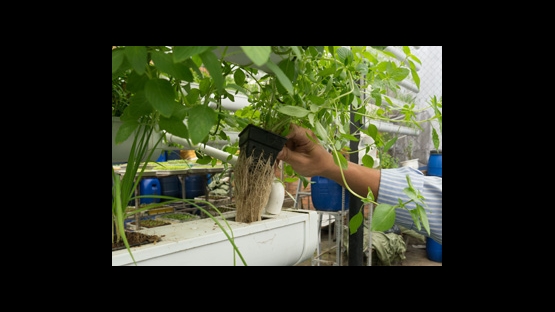Scientists are using seaweed, shrimp shells, sago starch, cassava starch, and palm oil to make products that increase plant growth rates, and either eliminate disease or reduce plants' susceptibility to disease. By making use of these products, farmers can decrease their dependence on agro-chemicals, diminishing environmental stress and saving money.
These base materials are called natural polymers, and are irradiated to change their molecular structures, giving them plant enhancing properties. These substances, although exposed in a controlled process to an exact dose of radiation in a fraction of a second, do not become radioactive.
Bigger Better
Oligoalginate (radiation-processed alginates derived from brown seaweed) and oligochitosan (radiation-processed chitosan derived from shrimp shells) have proven extremely effective in increasing the growth rates and yield of crops like rice, corn, wheat, sugarcane, soybean, potatoes, tomatoes, lettuce, spinach, amaranthus and cabbage.
Plants treated with oligoalginate grow anywhere from 13% to 56% larger, and do so more quickly than plants not treated with oligoalginate.
The products made from natural polymers have also been shown to protect plants from diseases, by increasing disease resistance and killing diseases already present. Oligochitosan protects plants from fungal infection, suppressing fungal diseases on rice, wheat and tomatoes; and oligoalginate stops the spread of the Tobacco Mosaic Virus, a disease which infects well over 350 different species of plants, not just tobacco.
In Vietnam, oligochitosan produced by the Vietnam Atomic Energy Institute, has almost eliminated the use of harmful fungicides in agriculture across the country.
More Than Agriculture
Natural polymers are irradiated to create products that are useful in medicine, agriculture and cosmetics, and that are non-toxic and therefore environmentally friendly.
For example, at the IAEA Collaborating Centre for Radiation Processing of Natural Polymers and Nanosciences in Malaysia, chitosan and sago starch are being used to create wound dressings and cosmetic face masks. Sago starch is also used to make biodegradable plastic packing materials like those used to transport electronics.
In China and other countries, researchers have used radiation technology to create polymers that absorb toxic metals like arsenic, chromium, mercury, and strontium. This might be useful in wastewater treatment and pollution cleanup.
Better Than the Rest
Radiation processing is used to break chemical bonds and create new ones, making it possible to redesign natural polymers on a molecular level to serve a specific purpose.
Radiation processing has several advantages over conventional chemical methods for developing and manufacturing new materials and products. It's simpler and faster, more precise, and much cleaner because it changes the molecular structure of materials without requiring chemical catalysts or extreme physical conditions such as high temperatures and immense pressures; it neither uses toxic chemicals nor generates noxious fumes.
Many countries around the world, but primarily those in the Asia and Pacific region, are actively engaged in researching and developing new materials, patenting their discoveries, or bringing new products to market for sale domestically and internationally.
The IAEA, through its Radioisotope Products and Radiation Technology Section, with additional funding from the United Nations Development Programme, is working with Member States around the world to promote the adoption, manufacture and use of non-toxic, biodegradable polymers derived from plants and animals.


